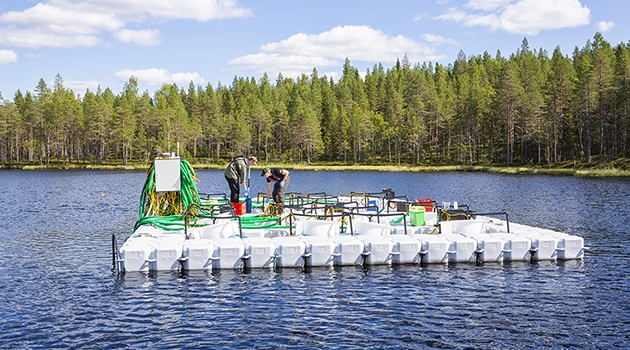To salt or not to salt icy roads?
Salt is used to de-ice roads to make them safer to drive on, but what are the negative impacts beyond rusting cars and angry letters to the editor? A new global study examines how life in lakes is impacted by increased salinity. The study shows that the impact is greater than previously thought.
In many places in Europe and North America, researchers see increased salinity in freshwater systems, arising from road salts but also from mining operations and agricultural fertilisers.
The researchers behind the new study looked at the sensitivity of zooplankton to increases in water salinity at 16 sites in Europe and North America. They examined mesocosms in the lakes, which are containers filled with enough salt water to contain nearly an entire ecosystem. In these separated settings, the researchers studied what happens to the organisms in the water when salinity increases. In Sweden, the research infrastructure SITES (Swedish Infrastructure for Ecosystem Science) contributed findings from three lakes from north to south: Stortjärn in Västerbotten, Erken in Uppland and Feresjön in Småland.
Negative impacts on zooplankton
The study shows that even salinities lower than current thresholds considered safe for aquatic organisms can have negative impacts on zooplankton, which are an important food source for many fish species. At half of the study sites, including one in Sweden, the loss of zooplankton triggered a cascading effect, causing an increase in phytoplankton biomass or microscopic freshwater algae. This leads to reduced light reaching the lakebed, which in turn can affect organisms living on the bottom. This, in turn, can negatively impact recreational opportunities, fisheries and drinking water quality.
Uppsala University. Photo: Mikael Wallerstedt
“It is concerning to see such a large-scale impact on freshwater organisms even at salinities below guidelines used in the EU and other places,” says Silke Langenheder, professor of limnology at Uppsala University and one of the Swedish participants in the study. “This means that using road salts is a greater threat to biological diversity and freshwater systems than we previously thought. We do not yet see any obvious problems in Sweden, but our findings show that we need to monitor this carefully.”
Icy roads more common
Hjalmar Laudon, professor of forest landscape biogeochemistry, is specialised in how water quality in boreal ecosystems is impacted by climate changes during the winter. His conclusion from the study is that there is every reason to monitor the negative effects of road salts from now on.
“At least in northern Sweden, we see that climate changes lead to more frequent periods where winter temperatures fluctuate around 0 °C, making icy winter roads common. This could lead to increased use of road salts that can damage organisms in lakes.”
Need to reassess guidelines
The researchers behind the study point to the need to reassess existing salinity guidelines and consider established guidelines in countries that lack them. Sweden, for example, only has guidelines for drinking water, which apply to areas with groundwater and surface water used for drinking water.
The study was led by researchers from the University of Toledo in the United States and Queen’s University in Canada. Several Swedish researchers and students from the Swedish University of Agricultural Sciences, Uppsala University, Linnaeus University, Karlstad University and Lund University contributed to the project.
Åsa Malmberg
Publication:
William D. Hintz et al. (2022), Current water quality guidelines across North America and Europe do not protect lakes from salinization, Proceedings of the National Academy of Sciences (2022). DOI: 10.1073/pnas.2115033119.

